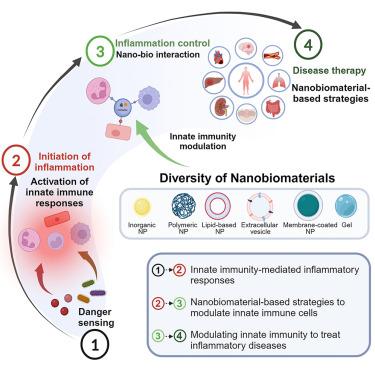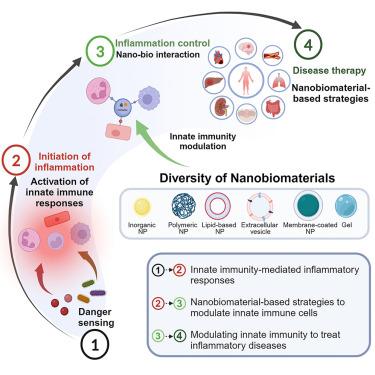用于控制炎症消退的先天免疫调节纳米生物材料
IF 17.3
1区 材料科学
Q1 MATERIALS SCIENCE, MULTIDISCIPLINARY
引用次数: 0
摘要
急性炎症反应是一种固有的保护机制,如果不能成功解决,就会导致疾病的发病,并有可能导致死亡。先天性免疫细胞是宿主的第一道防线,在炎症的引发、扩大、缓解或随后的疾病进展中发挥着重要作用。由于炎症的消退是一个活跃和高度调节的过程,因此调节先天性免疫细胞(包括中性粒细胞、单核细胞和巨噬细胞以及内皮细胞)及其相互作用为控制过度炎症提供了机会。由于纳米生物材料可以靶向先天性免疫细胞并与之相互作用,因此纳米生物材料在通过操纵炎症反应治疗炎症相关疾病方面显示出卓越的治疗潜力。多功能纳米生物材料的设计可以有针对性地调节特定的先天性免疫反应。目前已经制备出了具有促进溶解脂质介质和肽的纳米溶解药物,每种药物都在动物疾病模型中显示出了积极的炎症溶解作用。在此,我们回顾了用于调节先天免疫和缓解炎症的创新纳米生物材料。我们总结了将纳米生物材料的设计与纳米生物相互作用相结合的策略,以调节先天性免疫特征,推动纳米生物材料在炎症性疾病治疗方面的进步。我们还提出了纳米生物材料的未来展望和在这一迅速崛起的领域需要克服的转化挑战。本文章由计算机程序翻译,如有差异,请以英文原文为准。


Innate immunity-modulating nanobiomaterials for controlling inflammation resolution
The acute inflammatory response is an inherent protective mechanism, and its unsuccessful resolution can contribute to disease pathogenesis and potentially lead to death. Innate immune cells are the first line of host defenders and play a substantial role in inflammation initiation, amplification, resolution, or subsequent disease progression. As the resolution of inflammation is an active and highly regulated process, modulating innate immune cells, including neutrophils, monocytes and macrophages, and endothelial cells, and their interactions offer opportunities to control excessive inflammation. Nanobiomaterials have shown superior therapeutic potential in inflammation-related diseases by manipulating inflammatory responses because nanobiomaterials can target and interact with innate immune cells. Versatile nanobiomaterials can be designed for targeted modulation of specific innate immune responses. Nanopro-resolving medicines have been prepared both with pro-resolving lipid mediators and peptides, each demonstrating active resolution of inflammation in animal disease models. Here, we review innovative nanobiomaterials for modulating innate immunity and alleviating inflammation. We summarize strategies combining the design of nanobiomaterials with the nano-bio interaction for modulating innate immune profiles and propelling the advancement of nanobiomaterials for inflammatory disease treatments. We also propose the future perspectives and translational challenges of nanobiomaterials that need to be overcome in this swiftly rising field.
求助全文
通过发布文献求助,成功后即可免费获取论文全文。
去求助
来源期刊

Matter
MATERIALS SCIENCE, MULTIDISCIPLINARY-
CiteScore
26.30
自引率
2.60%
发文量
367
期刊介绍:
Matter, a monthly journal affiliated with Cell, spans the broad field of materials science from nano to macro levels,covering fundamentals to applications. Embracing groundbreaking technologies,it includes full-length research articles,reviews, perspectives,previews, opinions, personnel stories, and general editorial content.
Matter aims to be the primary resource for researchers in academia and industry, inspiring the next generation of materials scientists.
 求助内容:
求助内容: 应助结果提醒方式:
应助结果提醒方式:


